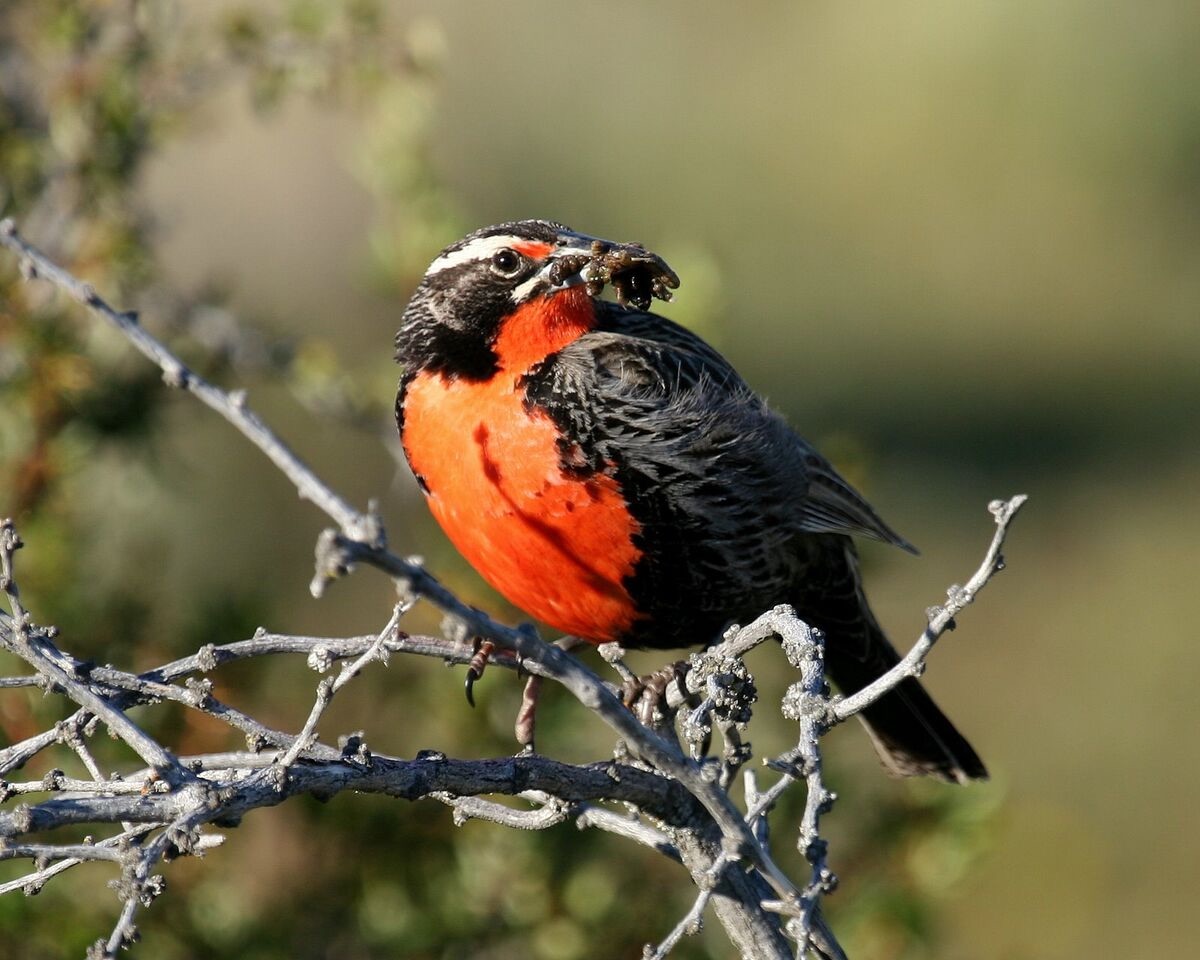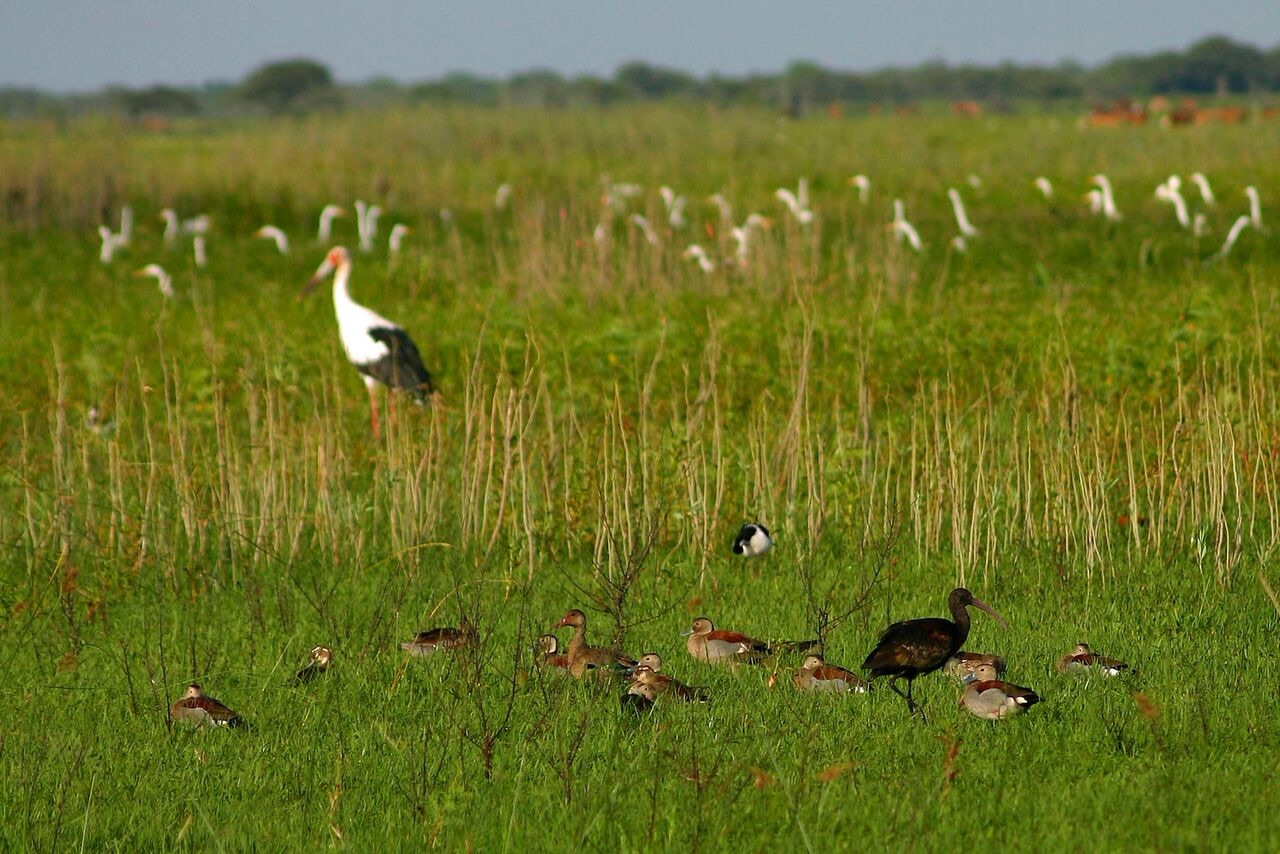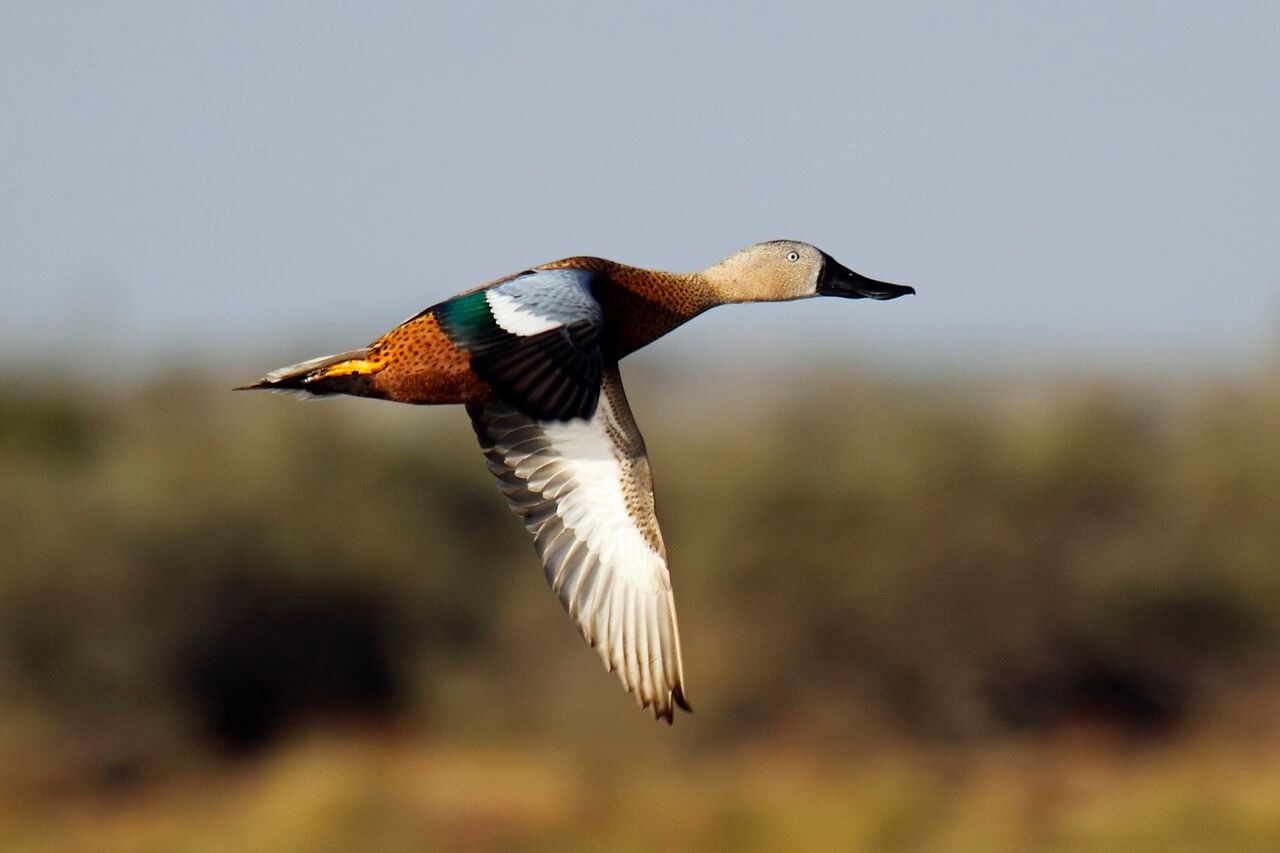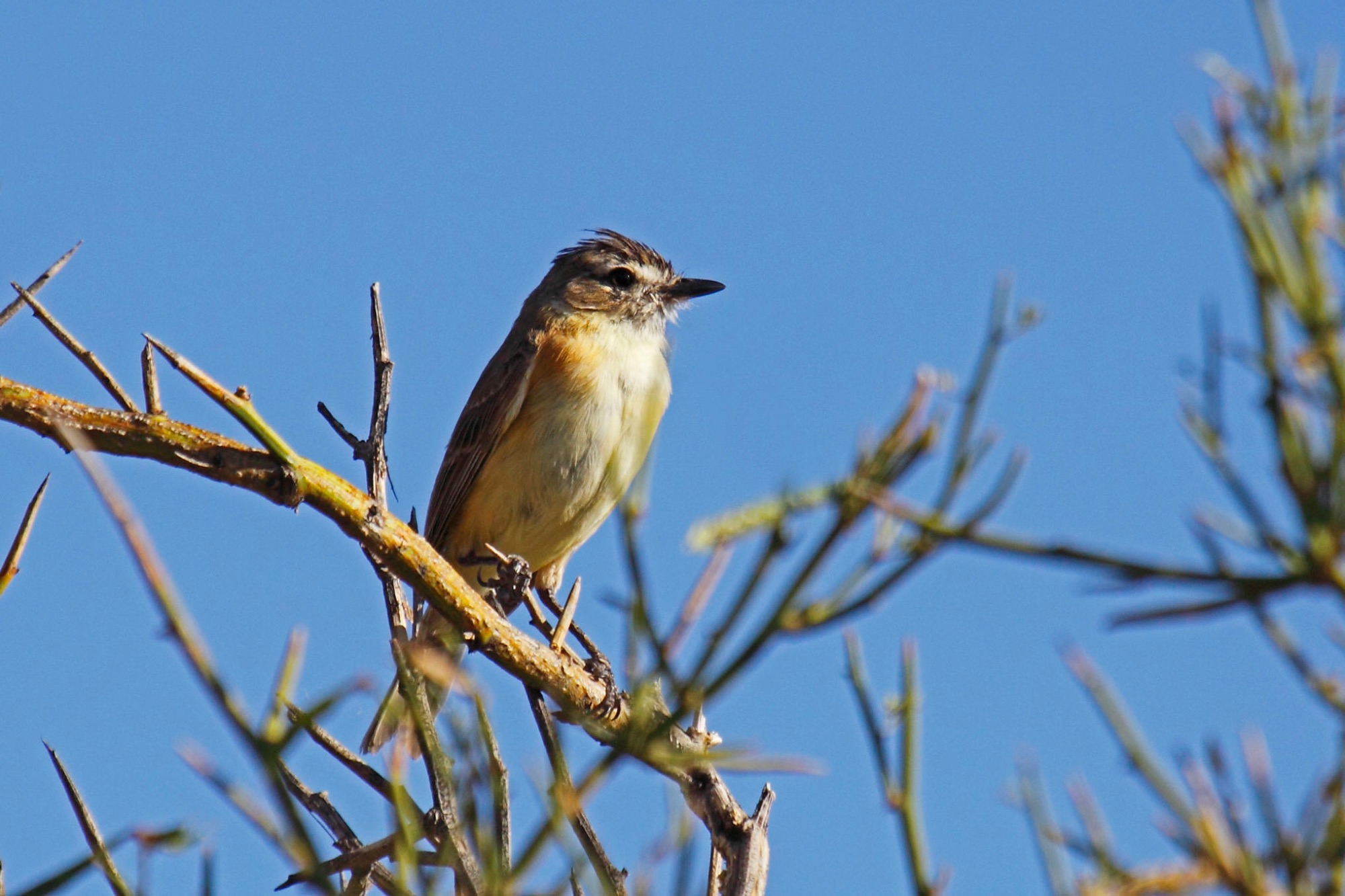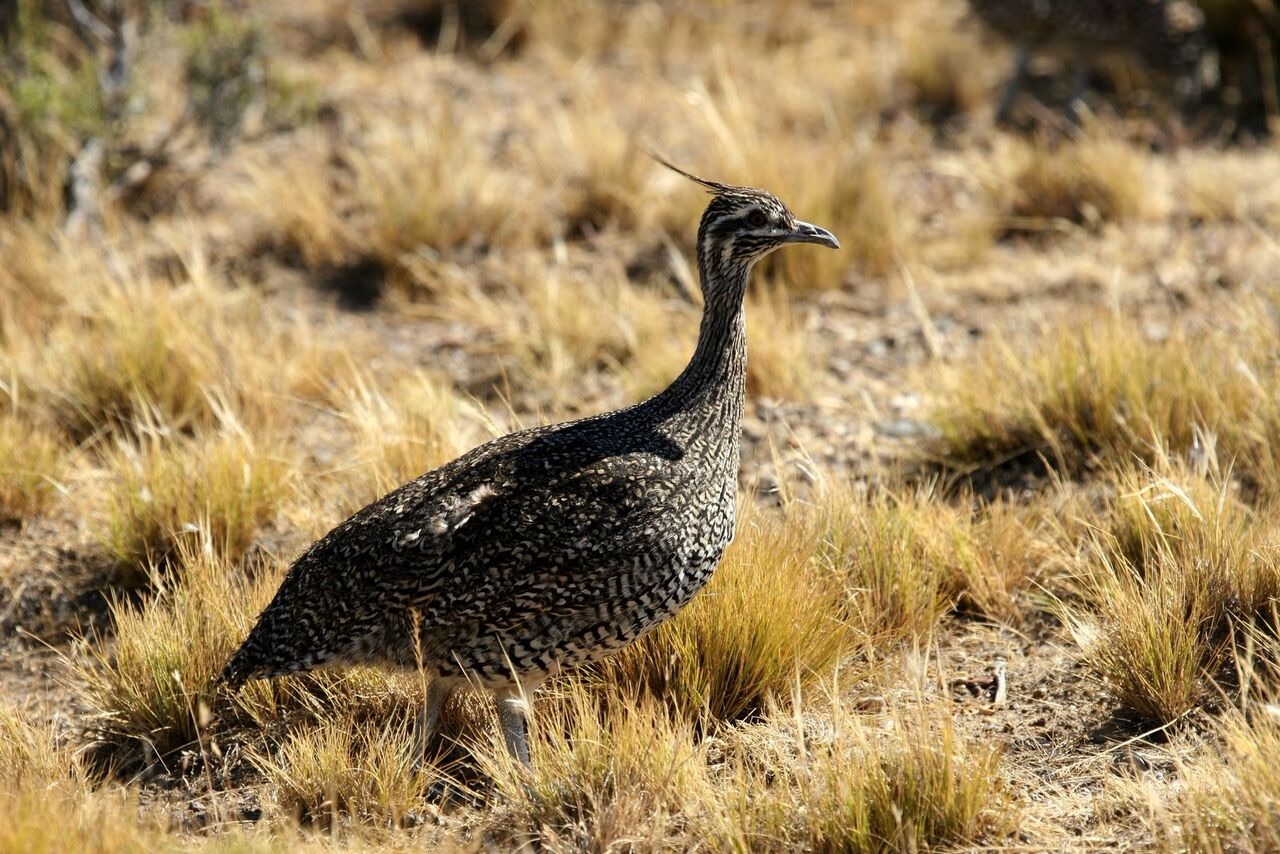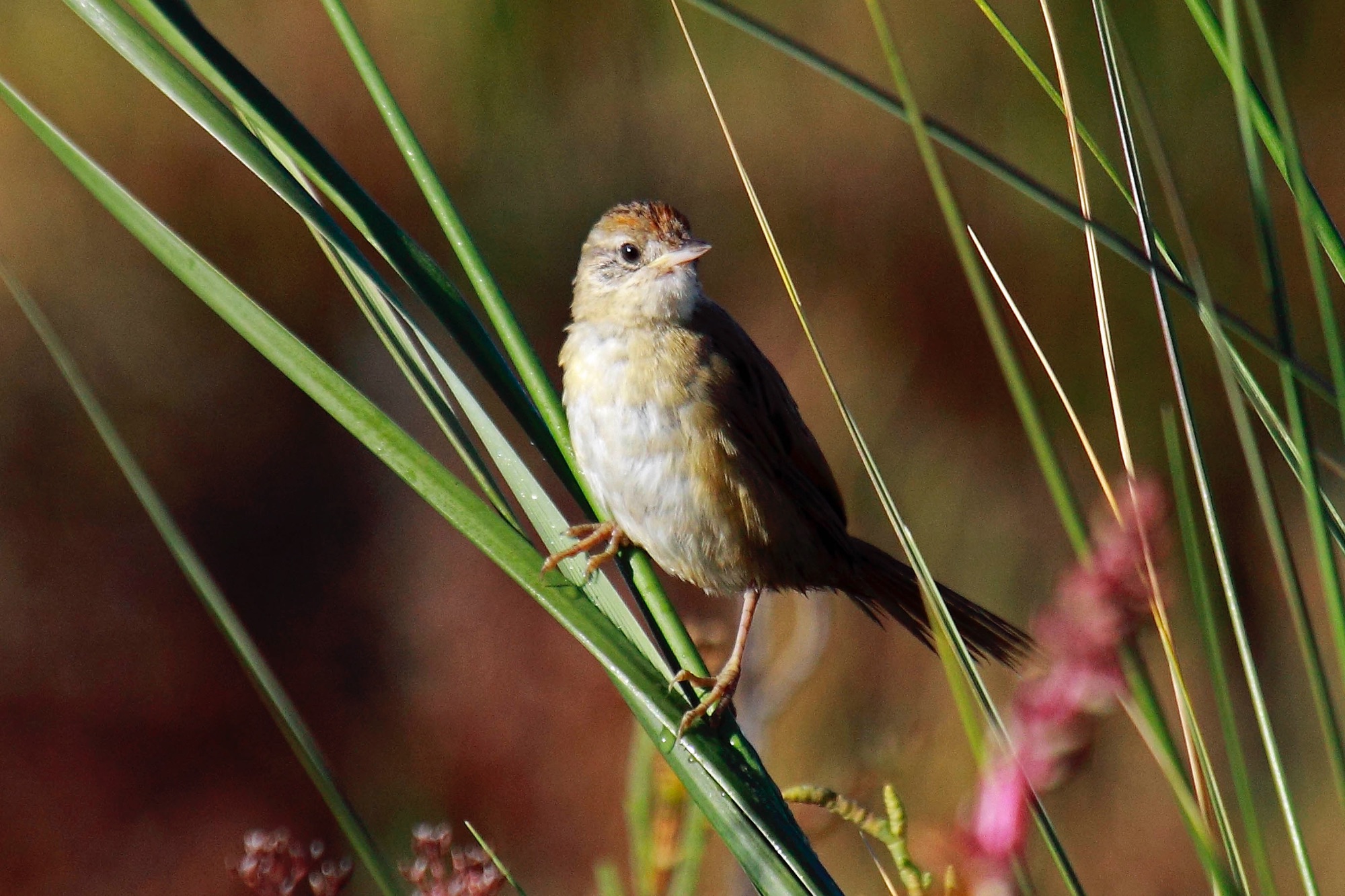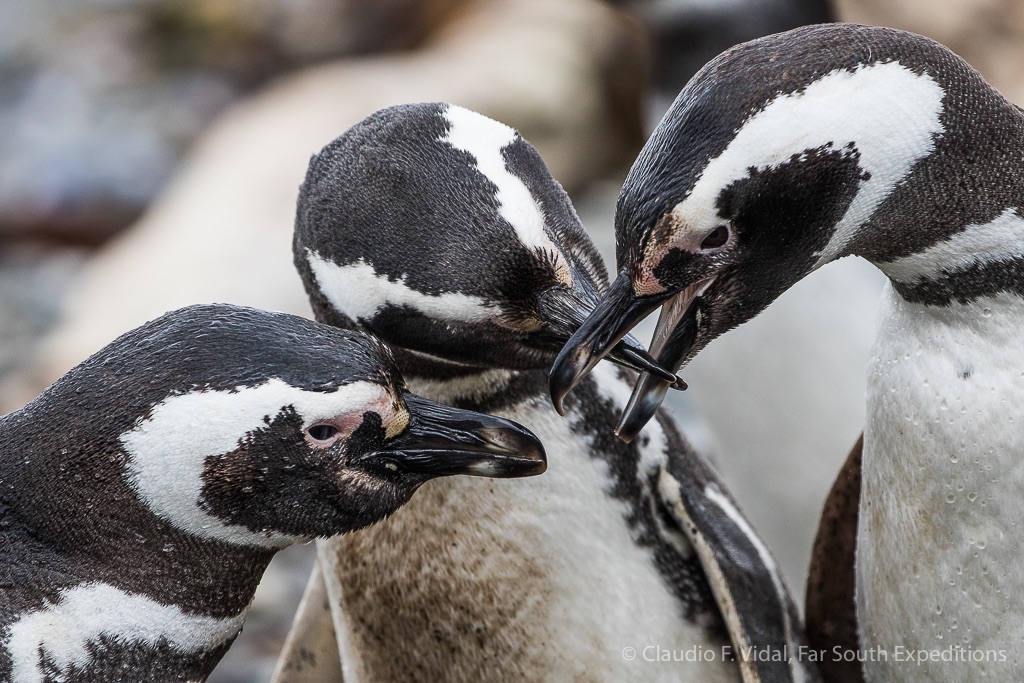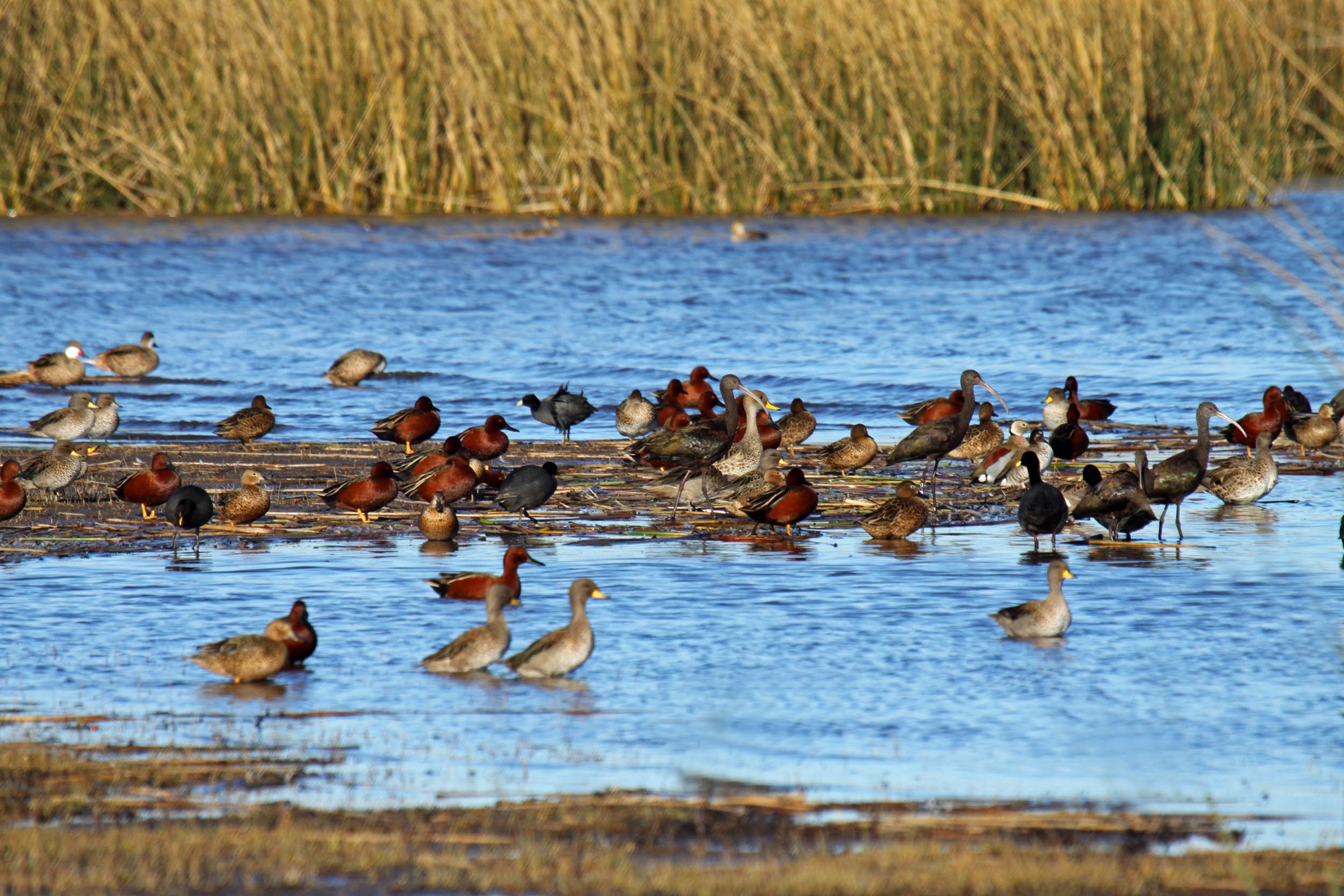SOUTHERN ARGENTINA & PATAGONIA
Day 1 Arrival in Buenos Aires, Argentina - 21st Nov
Following our morning arrival at Ezeiza International Airport in Buenos Aires we will transfer to our selected hotel, where we’ll spend the first night of the tour. After a rest and some lunch we can pay a visit this afternoon to the wonderful Costanera Sur Wildlife Reserve in the heart of Buenos Aires City. This 350 hectares reserve is
excellent for a first contact with the
Pampas’ birds and wildlife and by paying a
half-day visit one can
easily watch 50 or more species of birds.
Some of the species we hope to see include
White-tufted Grebe, Coscoroba and Black-necked Swans,
Lake Duck, Whistling Heron, Spot-flanked Gallinule, White-winged, Red-gartered and Red-fronted Coots, Plumbeous Rail, Chimango Caracara, Wattled Jacana, Monk Parakeet,
Picui Ground-Dove, Green-barred Woodpecker, White-rumped Swallow and many
passerines, such as Glittering-bellied Emerald, Masked Gnatcatcher,
Freckle-breasted Thornbird, White-crested Tyrannulet, Fork-tailed Flycatcher, Chalk-browed Mockingbird, Yellow-billed Cardinal, Rufous-bellied Thrush, Black-and-Rufous
Warbling-Finch, Spectacled Tyrant and Great Pampa-Finch. Several species of mammals and reptiles live here as well, and it is not unusual to find South American Coypu or Nutria, two species of opossums, Lesser Cavy, Common Teju Lizard, Hillary’s Side-necked Turtle and many others. Night in Buenos Aires.
Day 2 Buenos Aires - Otamendi - Ceibas
We will spend the morning at Otamendi National Park, a 3,000-hectare park located on the shores of the Paraná River just north of Buenos Aires, and is included in the international list of Important Bird Areas. It takes in three of the main bird habitats in Argentina: the Pampas Grasslands, the Thorny Woodland and the Paraná River Delta. Here we will be on the lookout for Straight-billed and Curve-billed Reedhaunters, Diademed Tanager and several widespread species like White-tufted Grebe, Southern Screamer, Long-winged Harrier, Giant Woodrail, White-tipped Dove, Checkered Woodpecker, Chotoy Spinetail, Warbling Doradito and Great Pampa-Finch. Once we are finished here we will head over to Ceibas, a wildlife area located across the Paraná River in the Province of Entre Ríos. Its particular bird abundance makes it really enjoyable for birders the world over and its dense thorny forests and marshlands are home to an incredible number of species, among which we hope to see Greater Rhea, Red-winged Tinamou, Savanna Hawk, White-fronted and White Woodpeckers, Scimitar-billed Woodcreeper, Brown Cacholote, Lark-like Brushrunner, Short-billed Canastero, and Tufted Tit-Spinetail. We will return to our hotel in time to get together for a recap of the places and wildlife seen in the Pampas thus far and enjoy our dinner. Night in Buenos Aires.
Day 3 Buenos Aires - San Clemente del Tuyu
Our drive from Buenos Aires to San Clemente de Tuyú is not particularly far across the pampas, and we shall spend the majority of the day birding the roadside verges en-route. The habitat is predominantly flat grasslands interspersed with lagoons, marshes and mud flats making for easy and rewarding birding. We can look forward to seeing a high number of species today with highlights likely to include Spotted Nothura, possibly the rare Dot-winged Crake, Chiloe Wigeon, Silver and Cinnamon Teals, Red Shoveler, Long-winged Harrier, Campo Flicker, Sulphur-bearded Spinetail, Greyish Bay-wing and Scarlet-headed Blackbird. Other species present include Black-necked Swan, Cocoi Heron, Bare-faced Ibis, Southern Crested Caracara, White-backed Stilt, Gilded Hummingbird, Hudson's Canastero, Spix's and Sulphur-bearded Spinetails, Warbling Doradito, Sulphur-breasted Spinetail, Creamy-bellied Thrush, Cattle and Spectacled Tyrants, Red-crested Cardinal, Brown-and-yellow Marshbird, Variable Oriole and White-browed Blackbird. A combination of effort and luck might elicit some of the trickier species such as Dot-winged Crake or even the much-wanted South American Painted-snipe. We shall spend the following two nights in San Clemente de Tuyú.
Day 4 Punta Rasa
The Bay of Samborombón and Punta Rasa are home to the most spectacular flocks of migrant waders, a wide array of grassland birds, and some unique mammals, like the scarce and elusive Pampas Deer. Northern migratory shorebirds such as American Golden Plover, Hudsonian Godwit, Red Knot, large numbers of White-rumped, Baird’s and Pectoral Sandpipers, and both Lesser and Greater Yellowlegs among others spend the northern winter (South American summer) in the southernmost tip of our continent, and Punta Rasa is one of the main feeding grounds for these long range travellers. They share the area with some local residents, such as Great Grebe, Chilean Flamingo, Black Skimmer, Kelp and Brown-hooded Gulls, Cabot’s Tern, Hudson’s Canastero, Blue-and-white Swallow, Firewood Gatherer, Bay-capped Wren-Spinetail, Long-tailed Reedfinch, Greater Rhea, Hellmayr’s and Correndera Pipits, Spotted Nothura, White-throated Hummingbird, and the highly localized Olrog’s Gull. Another nearby area holds Maguari Stork, Rosy-billed Pochard, Yellow-billed Pintail, Southern Screamer and possibly South American Painted Snipe and we also hope to find the beautiful Snowy-crowned Tern somewhere during our travels today. Night in San Clemente del Tuyu.
Days 5 San Clemente del Tuyu - Sierras de la Ventana
We will use the first part of this morning to try to find any missing species, with hopes of finding Giant Wood-Rail, Stripe-backed Bittern, Black-headed Duck, Curve-billed Reed-haunter, Sulphur-bearded Spinetail, Wren-like Rushbird, Warbling Doradito and Many-coloured Rush-Tyrant if we still need them. The rest of the day will be spent travelling, having lunch en-route and stopping by the side of the road if we find something interesting with birds such as Red-winged Tinamou, Dark-billed Cuckoo, Aplomado Falcon, Warbling Doradito, Freckle-breasted Thornbird, and both Black-and-rufous and Black-capped Warbling Finches amongst many possibilities. Night at Sierra de la Ventana.
Day 6 Sierras de la Ventana
The Sierras de La Ventana is a very old mountain chain situated in the Pampas. This mountain chain arose a long time ago and worked as a trap for many species becoming then an endemism centre, especially when we talk about plants. This area is protected by the Ernesto Tornquist Provincial Park with 6,718 hectares that holds more than 200 species of birds. Our primary target here is one of the rarest Argentinian endemics, Pampas Meadowlark. Other species here include Band-tailed Seedeater, Long-tailed Meadowlark, Pampas Pipit, Crested Gallito, Straneck's Tyrannulet, White-tipped Plantcutter, Chaco Earthcreeper, White-banded Mockingbird, Black-billed Shrike-Tyrant, Grassland Sparrow, Darwin's Nothura and the tiny Bearded Tachuri, to mention but a few. Night at Sierra de la Ventana.
Day 7 Sierras de la Ventana - Las Grutas
We will continue travelling south, passing through the coastal city of Bahía Blanca and its surroundings. While much of the day will be spent travelling, we can expect to add yet more species to our list and we will be keeping our eyes on the roadside verges for Darwin's Nothura and Brushland Tinamou, whilst the rare endemic Yellow Cardinal is also possible . On arrival at Las Grutas we will no doubt be greeted by flocks of Burrowing Parrots, as these are very common here. After checking into our hotel we will then go birding along the coast where we will look for birds that include the endemic Sandy Gallito, Carbonated Sierra-Finch, Hudson’s Black Tyrant, Scale-throated Earthcreeper, White-throated Cacholote, White-tipped Plantcutter, Austral Thrush, Common Diuca-Finch Greater Wagtail-Tyrant and White-tipped Plantcutter. We spend the following two nights in Las Grutas, a small village turned popular beach resort.
Day 8 San Antonio Oeste - Las Grutas
We will start early this
morning to bird the surrounding
areas of San Antonio Oeste. Our first
stop will be just outside the city
boundaries where we will try for
two more Argentine endemics, the
White-throated Cacholote and Sandy
Gallito (if we missed it yesterday).
Here we also have a good chance for
Elegant Crested Tinamou, Southern Martin, Black-
crowned and White Monjitas, Grey-
hooded and Mourning Sierra
-Finches and Vermilion Flycatcher.
We will then drive eastwards to search for the endemic Pale-breasted Spinetail, Plain-mantled Tit-Spinetail, Short-billed Canastero, Chaco Warbling-Finch, Golden-billed Saltator and the endemic Cinnamon Warbling-Finch. Night at Las Grutas.
Day 9 Las Grutas - Valdes Peninsula
We will spend the morning birding the surroundings of Las Grutas in search of any birds we might have missed in this area - Checkered Woodpecker, Sharp-billed Canastero, Yellow-billed Tit-Tyrant, White-winged Black Tyrant, Lesser Shrike-Tyrant, Patagonian Mockingbird, Common Diuca-Finch, Cinnamon and Ringed Warbling-Finches and Carbonated Sierra-Finch are all possible, before starting our way southwards to the Valdés Peninsula.
The Valdés Peninsula is a marine mammal’s paradise and is famous for its large colonies of seabirds and mammals, and for those wishing to do so will be able to watch Southern Right Whales on a boat tour this afternoon where we can get amazing close views of these huge creatures. We will also bird the surroundings of Puerto Pirámides in search of species such as Chilean Flamingo, Silvery Grebe, Crested Duck, Lesser Rhea, the endemic Rusty-backed Monjita, Common Miner, Patagonian Mockingbird, Plain-mantled Tit-Spinetail, Streak-throated and Band-tailed Earthcreepers, Grey-bellied Shrike-Tyrant, and the endemic Patagonian Canastero. There's also some interesting steppe dwellers to find in the surrounding area that includes Elegant Crested Tinamou, Cinereous Harrier, Short-billed Pipit, Austral Negrito, and Common Diuca-Finch.
Offshore we could see a few Southern Giant Petrels and Brown Skuas patrolling, whilst other possibilities include Blackish Oystercatcher, Snowy Sheathbill, Patagonian Canastero, Patagonian Mockingbird, Lesser and Grey-bellied Shrike-Tyrants, Rusty-backed Monjita and Two-banded Plover. There's even an outside chance of the rare Austral Rail here. We should also find some interesting land mammals that include Guanaco, Patagonian Mara, and if we are lucky South American Grey Fox, Humboldt’s Hog-nosed Skunk and the Large Hairy Armadillo. There are also impressive colonies of Elephant Seals and South American Sealions on the beach below, and there's a good chance of seeing Killer Whales hunting close to shore. Night at the seaside village of Puerto Piramides with great views overlooking the coastal bay.
Day 10 Valdes Peninsula - Punta Tombo - Comodoro Rivadavia
This morning we will drive south along the coast of the Atlantic Ocean in order to visit Punta Tombo, which is home to the largest seabird colony on the Patagonian coast. It is here that around half a million Magellanic Penguins gather every year to breed in the roughly 200,000 active nests! This is a very special place and as the visitor’s trail passes through a high density penguin area, we will be able to view and photograph these birds at very close range. Besides the penguins, there are also many other exciting birds here and these include the highly restricted Argentine endemic, Chubut Steamer-Duck and we will spend plenty of time in order to get decent views of this much-wanted species. We should also see both Imperial and Rock Shags, Chilean Skua, Dolphin and Kelp Gulls and South American Terns.
From Punta Tombo we continue our journey southwards to the town of Comodoro Rivadavia, our gateway to the High Plateau and our forthcoming search for Hooded Grebe. Birds in the area include Scaly-throated and Band-tailed Earthcreepers, Plain-mantled Tit-Spinetail, White-throated Cacholote, Grey-hooded Sierra-Finch and Patagonian Yellow-Finch, Night at Comodoro Rivadavia.
Day 11 Comodoro Rivadavia - Los Antiguos
We will leave the Atlantic coast of Patagonia this morning and set off for a long drive to the small village of Los Antiguos, sitting in the heart of Patagonia's High Plateau not far from the Andes, and from the fantastic Patagonia National Park. The drive will give us the chance to experience Patagonia's wilderness first-hand. Patagonia is for the most part a region of vast steppe-like plains, rising in a succession of abrupt terraces about 100 meters at a time, and covered with an enormous bed of shingle almost bare of vegetation. In the hollows of the plains are ponds or lakes of brackish and fresh water. Towards the Andes the shingle gives way to porphyry, granite and basalt lavas, and animal life becomes more abundant and vegetation more luxuriant, acquiring the characteristics of the flora of the western coast, consisting principally of southern beech and conifers. Birds en-route include the rare Patagonian Tinamou, Chilean Swallow and Black-chinned Siskin amongst others. We shall spend the next three nights at Los Antiguos.
Days 12 - 13 Patagonia National Park
We will spend these two days exploring different locations inside the national park, looking for Hooded Grebe. This species breeds on a few basaltic lakes in the interior of Santa Cruz, extreme southwest Argentina. The total population was estimated at 3,000-5,000 individuals in 1997. Counts on the wintering grounds suggested a decline of 40% over a seven-year period. During the 2010-2011 breeding season 535 individuals were counted, indicating a population decline of more than 80% over the last 26 years. In 2013, greater resources allowed a simultaneous count across all plateaus known to have ever held grebes and visiting virtually every lake with historic records of the species, resulting in a count of 691 adults and 144 chicks in 12 colonies. During the summer of 2014/2015, 771 adults, 138 juveniles and 12 colonies were recorded across 18 lakes. Nowadays, the main core of the breeding population is found within the boundaries of Patagonia National Park, so we hope to spend time watching and photographing these unique birds in their natural habitat. Besides Hooded Grebe, this is also a wonderful place to look for other Patagonian specialties including birds like Andean Condor, Patagonian Tinamou, Upland Goose, Tawny-throated Dotterel, Short-billed Miner, Cinnamon-bellied and Dark-faced Ground-Tyrants, Buff-winged Cinclodes, Scaly-throated Earthcreeper, Chocolate-vented Tyrant, Austral Negrito and Grey-hooded Sierra-Finch to name but a few. Nights at Los Antiguos.
Day 14 Los Antiguos - Comodoro Rovadavia - 4th December
We will leave Los Antiguos this morning and drive all the way back to Comodoro Rivadavia, where the tour ends at the local airport.
Please note this itinerary is liable to change according to latest news on the location of Hooded Grebe.
All photos copyright Luis Segura.
Just hover your cursor over each image for info.

